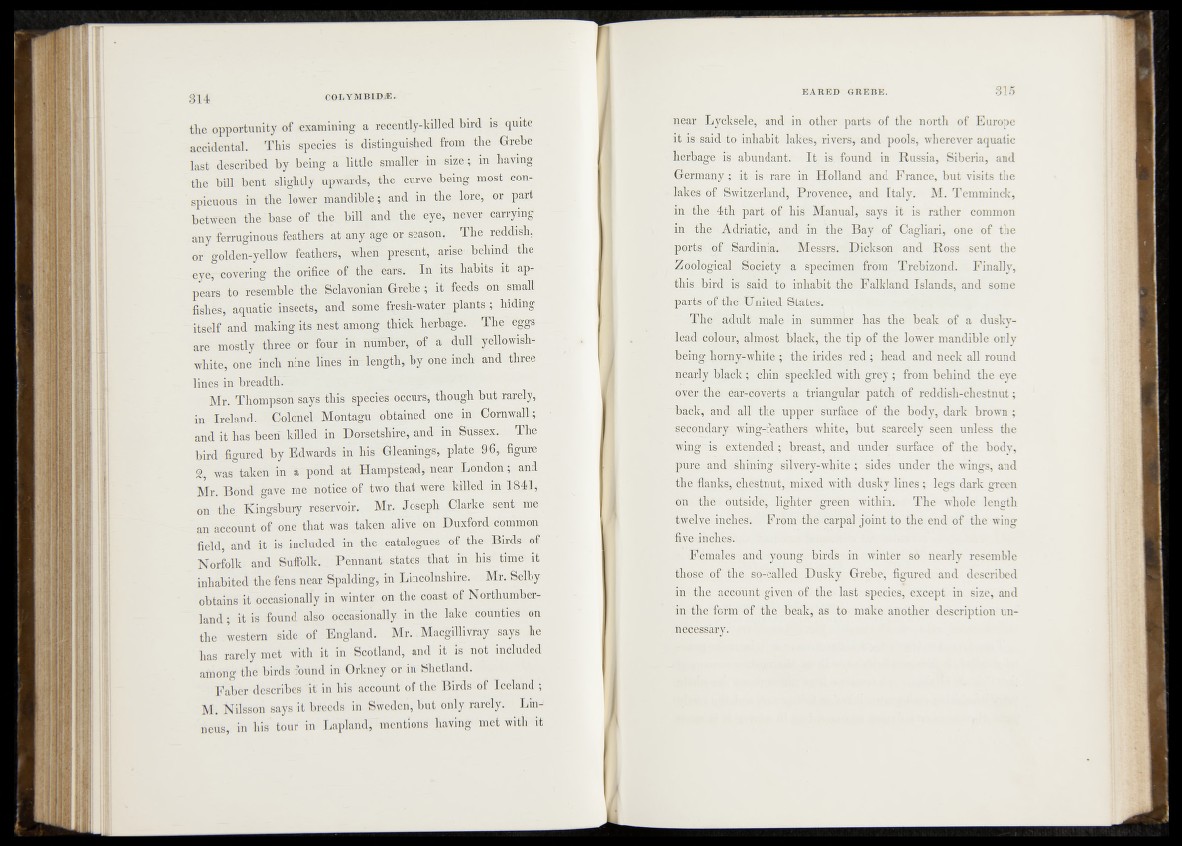
the opportunity of examining a recently-killed bird is quite
accidental. This species is distinguished from the Grebe
last described by being a little smaller- in size; in having
the bill bent slightly upwards, the curve being most conspicuous
in the lower mandible; and; in the lore, or part
between the base of the. bill and the- eye, neve*, carrying
any ferruginous feathers at any age or season. The reddish,
or' golden-yellow feathers, where present, „arise-'-behind the
eyercovering the orifice of the : ears. In its - habits it appears
to resemble the Sclavonian Grebe; it feeds on small
fishes, aquatic insects, and somer fresh-water-plants ; hiding
itself and making its nest among thick herbage. The^eggs-
are mostly three or four in number, of a dull' yellowish
white, one inch nine lines in length, by one inch and three
lines in breadth.
Mr. Thompson says this species occurs, though but rarely^
in Ireland. Colonel Montagu obtained one-ifi Cornwall
and it has been,killed in Dorsetshire, and In Sussex. The
bird figured by Edwards in his Gleanings, p la te d 6, figure
2, was taken in a“pond at Hampsteadj-near London; and
Mr. Bond gave me notice of two that were killed in ^841,
on the. Kingsbury reservoir. Mr. Joseph Clarke fs^hh me
an account of one that was taken alive on Duxford common
field, and it is included in the catalogues of the Birds of
Norfolk and Suffolk. Pennant states that in h istimet it
inhabited the fens near Spalding, in Lincolnshire. Mr. Selby
obtains it occasionally in winter on the coast of Northumberland
; it is found also occasionally in the lake counties on
the western side of England. Mr. Macgillivray says he
has rarely met with it in Scotland, and it is not included
among the birds found in Orkney of in Shetland.
Faber describes if in his account of the Birds of Iceland ;
M. Nilsson says it breeds in Sweden, but only rarely. Linn
e t in his tour in Lapland, mentions having met with it
near Lycksele, and in other parts of the north of Europe
it is said to inhabit lakes, rivers, and pools, wherever aquatic
herbage is abundant. I t is found in Russia, Siberia, and
Germany.;- it is rare in Holland and France, but visits the
lakes of Switzerland, Provence, and Italy. M. Temminck,
in the 4th part of his Manual, says it is rather common
in the Adriatic, and in the Bay of Cagliari, one of the
ports of Sardinia. Messrs. Dickson and Ross sent the
sllpologicafl; Society a specimen from Trebizond. Finally,
thi&dbird is said to inhabit the Falkland Islands, and some
parts of the,.United States.
T ]|g | adult male in summer has the beak of a dusky-
lead colour, almost Mack, the tip of the lower mandible only
being horny-white ; the irides red ; head and neck all round
nearly black; chin' speckled with grey; from behind the eye
over the ear-coverts a triangular patch of reddish-chestnut;
"back, and all the upper surface of the body, dark brown ;
||^,©‘ndaay>s*wing-feathers white, but scarcely seen unless the
wing“is ieixteU.ded; breast, and under surface of the body,
pure and shining- silvery-white; sides under the wings, and
the flanks, chestnut, mixed with dusky lines; legs dark green
on the outside, lighter green within. The whole length
twelve inches. From the carpal joint to the end of the wing
five inches.’ .
f Females and young birds in winter so nearly resemble
those of the so-called Dusky Grebe, figured and described
in* the account given of the last species, except in size, and
in the form of the beak, as to make another description unnecessary.